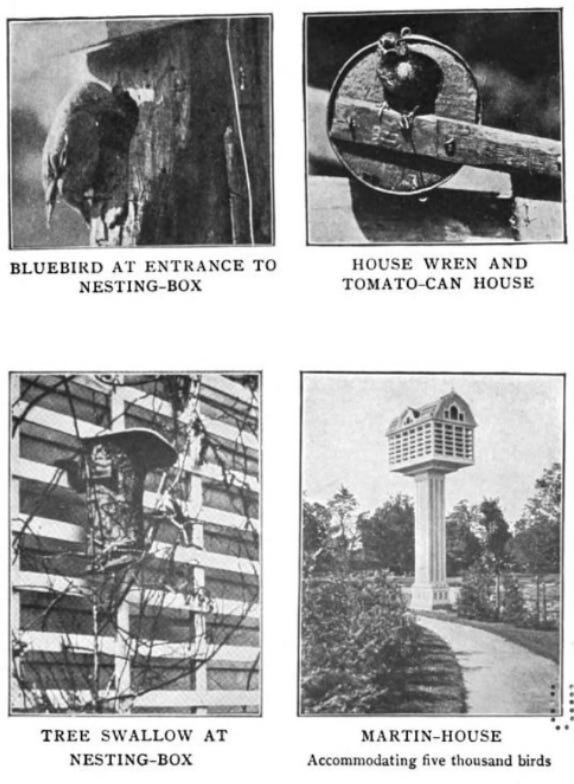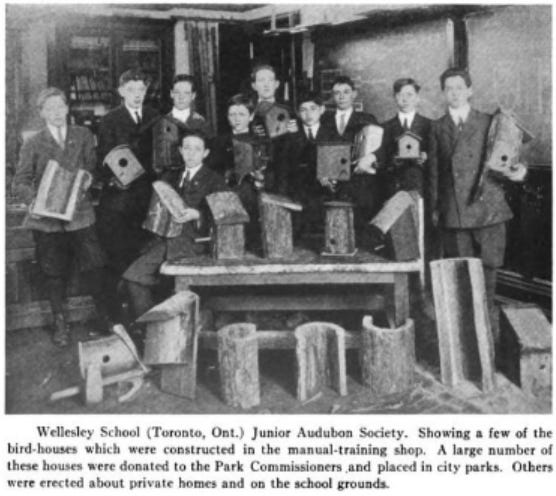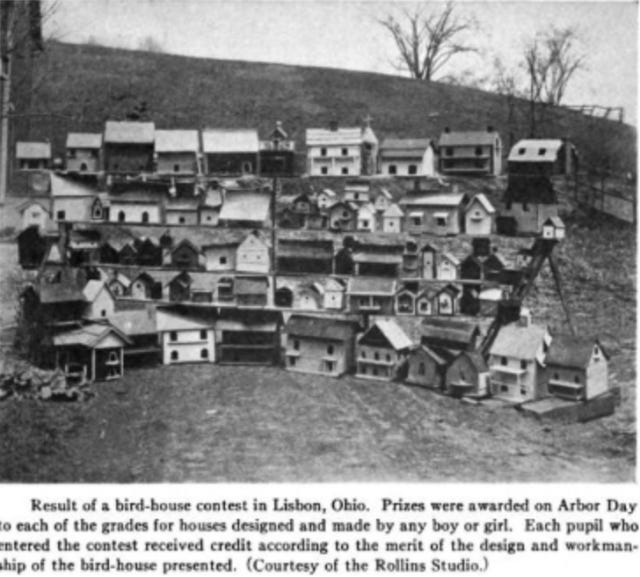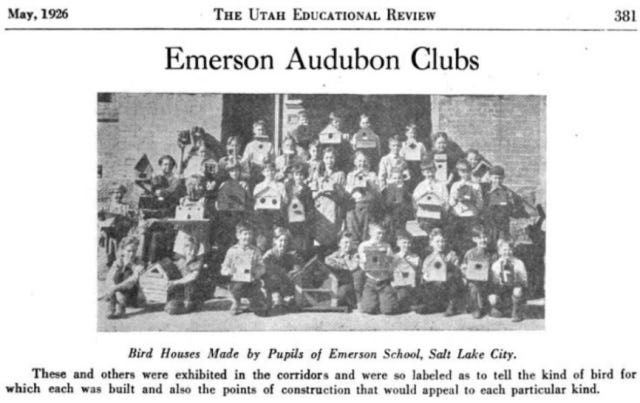Boy Bird House Architecture
In the Progressive era, students learned to build birdhouses to end “the cruel sacrifice of birds of song by the truant school-boy”
“In St. Paul, Minnesota, the boys like to go to school, and when they get into the sixth grade it is hard to pry them out. At that stage in their schooling a wise board of education has instituted manual training, for every fourteen-year-old boy is a carpenter at heart. And they don’t make corner brackets solely. They make bird houses.”
This was how the Ladies’ Home Journal opened their February, 1916 article about the excitement that swept St. Paul schools and communities every spring when the city’s annual bird house building contest came around. “The sixth-grade kid in St. Paul who isn’t putting the finishing touches to a bird house early in March is rare,” reported the Journal, and once the houses were “all finished, three or four thousand of them, you can see lads coming down every street in town to the registration office. There they enter their houses in the big annual bird-house exhibit, whereupon the contest really begins, with the whole city interested.”1
This annual phenomenon was hardly a local innovation, nor was it unique to St. Paul. With encouragement from schools, state governments, women’s clubs, and most importantly, local and national chapters of the Audubon Society, hundreds of thousands of children throughout the country were competing to build the finest bird houses in their schools. From Rochester and Cincinnati to the tiny town of David City, Nebraska, schools instructed children to build birdhouses, not only to learn construction skills, but because schools considered it critically important that children learn to love and protect birds.
Bringing Birds Back
Since the early 19th century, farmers struggling against the ravages of insects on their crops believed that birds were one of the few forces keeping pest populations in check. “They are the barrier, which the benevolent Creator has set against the inordinate multiplication of the insect tribes, and they can not be hunted, and driven away from our cultivated fields, without destroying the harmony of God’s providential arrangements,”2 wrote the American Agriculturist in 1859. Yet by clearing forests, draining the wetlands, plowing under the prairie, Americans had done precisely that.

The growth of cities also meant, in the words of Gilbert Trafton in 1916, that “orchards, decaying trees, shrubbery, and other nesting-sites are steadily disappearing. As a result, in the suburbs of cities birds that nest in cavities find it difficult to obtain suitable nesting-sites, and as the old sites are cut down the birds are driven farther out into the country to nest.”3 Other writers agreed, claiming that “these useful birds have been so destroyed as to be almost exterminated, and the increase of destructive insects that frequent the field, orchard, and garden is appalling.”4
This absence of birds was throwing the natural world out of whack, and bird houses were the chosen remedy for restoring nature’s equilibrium. “We must provide homes for the birds that nest in hollow trees, as there are no longer holes enough to go round,” wrote the ornithologist Edward Forbush in 1915.5 And the federal government lent its support to this goal. “Uncle Sam has for you a booklet which tells you how to make all sorts of bird houses,” wrote Dudley Harmon in 1916. Invoking the patriotism that was then at the country’s all-time high, he continued, “Government experts say our birds need your hospitality.”6 These US Department of Agriculture bulletins, containing blueprints for building birdhouses, advised that “birds are desirable about premises not only on account of their beauty and song, but because of their economic worth.”7

Birds and Boys
But when conservationists and educators began enlisting legions of boys to construct birdhouses in their middle school school shop classes, it was not just in the interest of bringing birds back to the suburbs. They were trying to accomplish deeper moral reforms as well. Since at least the early 1800s, “the cruel sacrifice of birds of song by the truant school-boy”8 was almost a cliche. Boys amused themselves by collecting eggs from nests, and the songbirds that visited their backyards made irresistible targets to practice their aim with slingshots or air rifles.
While there was a growing appreciation that birds deserved protection in their own right, there was just as much concern that boys who learned to kill birds as children would grow into delinquent adults. “A boy that would rob a bird’s nest or hurt a lost dog is likely to become a citizen both dishonest and dangerous.” On the other hand, “the boy or girl who loves birds and is kind to helpless domestic animals is not likely to become cruel or ungenerous with associates … The chances are that the bird-loving boy or girl will make the better citizen.”9

In 1920, Leon Baxter, who was the director of the manual training program (what we now call shop class) in St. Johnsbury, Vermont’s public schools, published a guide to bird house construction called Boy Bird House Architecture, which became widely used in schools throughout the country. While he claimed that “any town or community that protects its birds insures its harvests against destruction by insect pests,” his real motivation for putting together the guide book was “to lead the boy and girl toward their proper relationship with their feathered friends of the air, and to instill the feeling of protection toward our native birds.”10 By getting boys to do the building, you might say he was killing two birds with one stone.
Bird Houses in Schools
While the early Audubon Society became famous for creating wildlife refuges and advocating for state and national laws for the protection of birds, a strategy that was just as central to their approach was educating the next generation to love and protect birds. Most of this work was carried out by local Audubon Society chapters working closely with schools, where they were active “in teaching school children throughout the country to erect little bird houses in their gardens and so to furnish a sanctuary for the birds.”11

It’s hard to know exactly how widespread the practice of building birdhouses in schools was, but by 1915, Audubon could claim in its official publication, Bird-Lore, that “in thousands of schools this kind of work has already been begun by eager children under the direction of earnest teachers.”12 And the organization’s reach was only growing. By 1927, a total of 8,697 Junior Audubon Clubs enrolled over 355,000 students, with each club usually being led by a public school teacher.13

Reporting from local and national periodicals gives us a sense both of how widespread the practice was, and of how much it interested the general public. In Elgin, Illinois, for example, the Audubon society worked with the Board of Education to include birdhouse construction in the school curriculum, and in 1915 this “resulted in 250 Wren-houses and 12 Martin-houses being built, the largest having 54 rooms.”14 In Cincinnati, “boys in the manual training department are not only instructed how to build bird houses for themselves but are expected to build bird houses for the girls.”15 In Prescott, Arizona, “boys built their bird houses as a matter of patriotism and were proud to hold them under the flag.”16 It was also noticed when schools were not teaching birdhouse construction. A 1923 bulletin from the University of North Dakota scolded the state’s teachers for their “sporadic practice,” as “few schools in the state construct bird houses every year.”17
Children learned to customize birdhouses for dozens of bird species based on the unique needs and behaviors of each one. They received guidance on best birdhouse practices, for example, to “avoid all gloss paints as they reflect light and tend to drive away rather than attract the birds,” and place birdhouses “high enough to be out of the way of prowling cats or too inquisitive human beings.”18 Much of the guidance dealt with keeping house sparrows, “the greatest and most ubiquitous enemy of all native birds that nest in bird houses,”19 from moving in. Boys should avoid adding perches, for example, because “the sparrows alight there and by their incessant chirping drive out or annoy the more desirable occupants.”20

Bird House Contests
As a bit of extra motivation for the boys, and to involve the entire community in bird preservation, it was very common for towns to arrange annual birdhouse building contests. Peoria, Illinois held their first-ever bird house contest in 1916, and divided contestants into one category for seventh-grade boys, one for eighth-grade boys, one for “commercial manufacturers of bird houses,” and a general category for “any friend of birds.”21 Two years later, the contest had grown to 610 entrants, which “10,000 enthusiastic visitors” gathered to see.22

Boys competed for boy-oriented prizes, like the fishing rods, “a number of fine quality jack knives,” and a subscription to American Boy, all offered by the Board of Education in Massena, New York.23 “And besides the prizes,” said the Ladies’ Home Journal, “there are hundreds of grown-ups eager to buy the houses at the prices the little builders set on them, for everyone almost in St. Paul has a bird house somewhere about the outside of his domicile.” Cities bought many of the birdhouses to place in parks, as did “the big real-estate companies,” who “discovered that the placing of the bird houses on development tracts drew the birds there and helped the sale of the building lots.”24
Did It Work?
At least according to birdhouse backers, the instructional programs had a remarkable effect on the boys who would otherwise be terrorizing the town birds. In Vermont, Baxter reported that “through this instruction our boys are proud to be considered natural guardians of bird houses in our town, which is veritably a bird sanctuary.”25 Much the same narrative prevailed in St. Paul, where the city’s Humane Society “has gone out of business so far as bird-killing warnings are concerned, for every kid in town is the legal guardian of the birds, and the wicked sling shot, which has all too often driven them from other localities, is there a device unknown.”26
While it’s hard to isolate the effect that building birdhouses had on boys, it’s impossible to deny the profound cultural shift that took place in children’s attitudes toward birds during this era. Through school-based instruction on the importance of bird life, not least of all in shop class, “children have come to learn the various birds that frequent their localities,” wrote Jerome Lachenbruch in 1921. “And what is more important to the children’s development,” he continued, “they have cultivated a love for the birds that expresses itself in a personal interest in the birds that pay them periodical visits.”27
“The City of Song Birds.” Ladies’ Home Journal. United States: Curtis Publishing Company, 1916.
American Agriculturist. New York, May 1859. Volume 18, no. 5.
Trafton, Gilbert Haven. Bird Friends: A Complete Bird Book for Americans. United States: Houghton Mifflin, 1916.
Timmons, John. “Homes for Insectivorous Birds.” Harper’s Weekly. United States: Harper’s Magazine Company, 1913.
Forbush, Edward Howe. Bird Houses and Nesting Boxes. Massachusetts State Board of Agriculture Circular No. 47. United States: Wright & Potter Printing Company, State Printers, 1915.
Harmon, Dudley. “My Government And I”. United States: Curtis Publishing Company, 1916.
Dearborn, Ned. “Bird Houses and How To Build Them.” US Department of Agriculture, Farmers’ Bulletin 609. September 11, 1914.
Wilkes’ Spirit of the Times. Vol. 10, no. 17, p. 262. June 25, 1864
State of Ohio Department of Public Instruction. Arbor and Bird Day Proclamation, Ohio Arbor Day Program. Bulletin No. 2, Whole Number 14. 1916.
Baxter, Leon H.. Boy Bird House Architecture. United States: Bruce publishing Company, 1920.
Lachenbruch, Jerome. “Bringing Bird Life to the Class Room” Moving Picture Age: A Monthly Publication Devoted to the Interest of Visual Instruction …. United States: n.p., 1921.
“Proper Bird-Boxes.” Bird Lore. United States: Macmillan Company, 1915.
“Report of T. Gilbert Pearson, President.” Bird-lore. United States: Macmillan Company, 1927.
“Clubs Affiliated with the National Association: Audubon Society of Elgin (Illinois).” Bird Lore. United States: Macmillan Company, 1915.
Swope, Eugene. “Audubon Educational Work in Ohio.” State of Ohio Department of Public Instruction. Arbor and Bird Day Proclamation, Ohio Arbor Day Program. Bulletin No. 2, Whole Number 14. 1916.
Bentley, J. W. “Arbor Day on the Prescott National Forest.” The Arizona Teacher and Home Journal. Vol 14-16. 1925.
“Houses for North Dakota Birds.” University of North Dakota Departmental Bulletin, Volume 7 No. 1. February, 1923.
Baxter, Leon H.. Boy Bird House Architecture. United States: Bruce publishing Company, 1920.
Forbush, Edward Howe. Bird Houses and Nesting Boxes. Massachusetts State Board of Agriculture Circular No. 47. United States: Wright & Potter Printing Company, State Printers, 1915.
Baxter, Leon H.. Boy Bird House Architecture. United States: Bruce publishing Company, 1920.
The Audubon Bulletin. United States: Illinois Audubon Society., 1916, p. 31.
“What Has It Done?: Bird House Exhibit.” Peoria Commerce. United States: Peoria Association of Commerce., Peoria, Illinois, Vol 2. No. 1. September 1, 1918.
Alsworth, Charles. “A Bird House Contest.” Industrial Education Magazine. United States: Manual Arts Press, 1922.
“The City of Song Birds.” Ladies’ Home Journal. United States: Curtis Publishing Company, 1916.
Baxter, Leon H.. Boy Bird House Architecture. United States: Bruce publishing Company, 1920.
“The City of Song Birds.” Ladies’ Home Journal. United States: Curtis Publishing Company, 1916.
Lachenbruch, Jerome. “Bringing Bird Life to the Class Room” Moving Picture Age: A Monthly Publication Devoted to the Interest of Visual Instruction …. United States: n.p., 1921.










Lovely! I’m inspired to try my hand at a bird house. We have orioles arriving in spring, I’ll have to investigate that.